Analyzing Socioeconomic Aspects of Rising House Prices in Australia
VerifiedAdded on 2023/06/11
|14
|4012
|241
Essay
AI Summary
This essay explores the socioeconomic factors responsible for rising housing prices in Australia, highlighting the impact of these prices on the Australian economy. It begins by emphasizing the importance of housing as a basic need and its role in the social and economic well-being of Australians. The study identifies key factors contributing to increased house prices, including interest rates, investment demand, the economic climate, financial deregulation, land supply, government taxes, demographic factors, and the wealth effect. The essay also discusses the positive and negative impacts of high housing prices, such as their effect on aggregate demand, economic activities, and wealth distribution. It concludes by noting that while high house prices can stimulate economic growth and create employment opportunities in the construction sector, they also pose challenges to housing affordability and wealth inequality. This document is available on Desklib, a platform offering study tools and resources for students.
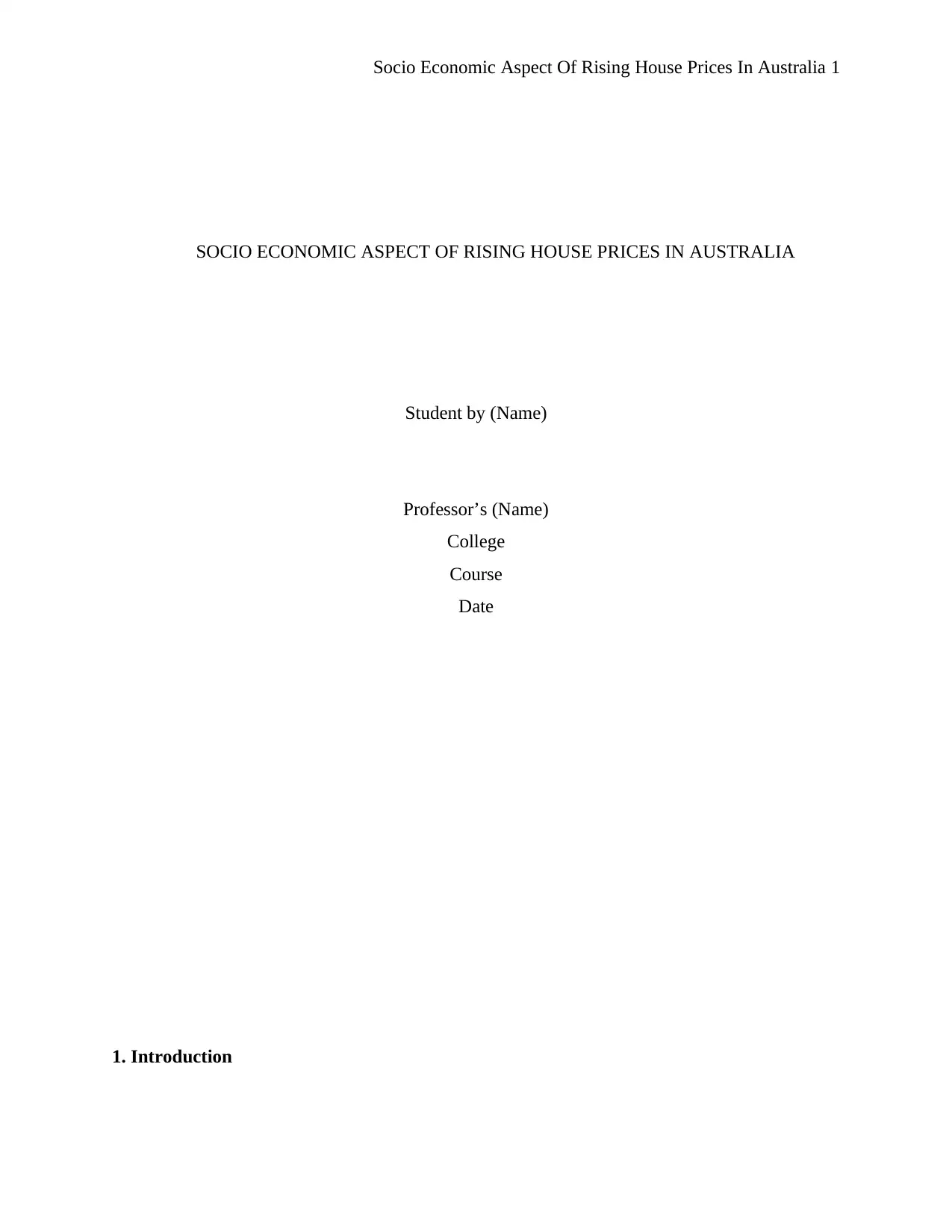
Socio Economic Aspect Of Rising House Prices In Australia 1
SOCIO ECONOMIC ASPECT OF RISING HOUSE PRICES IN AUSTRALIA
Student by (Name)
Professor’s (Name)
College
Course
Date
1. Introduction
SOCIO ECONOMIC ASPECT OF RISING HOUSE PRICES IN AUSTRALIA
Student by (Name)
Professor’s (Name)
College
Course
Date
1. Introduction
Paraphrase This Document
Need a fresh take? Get an instant paraphrase of this document with our AI Paraphraser
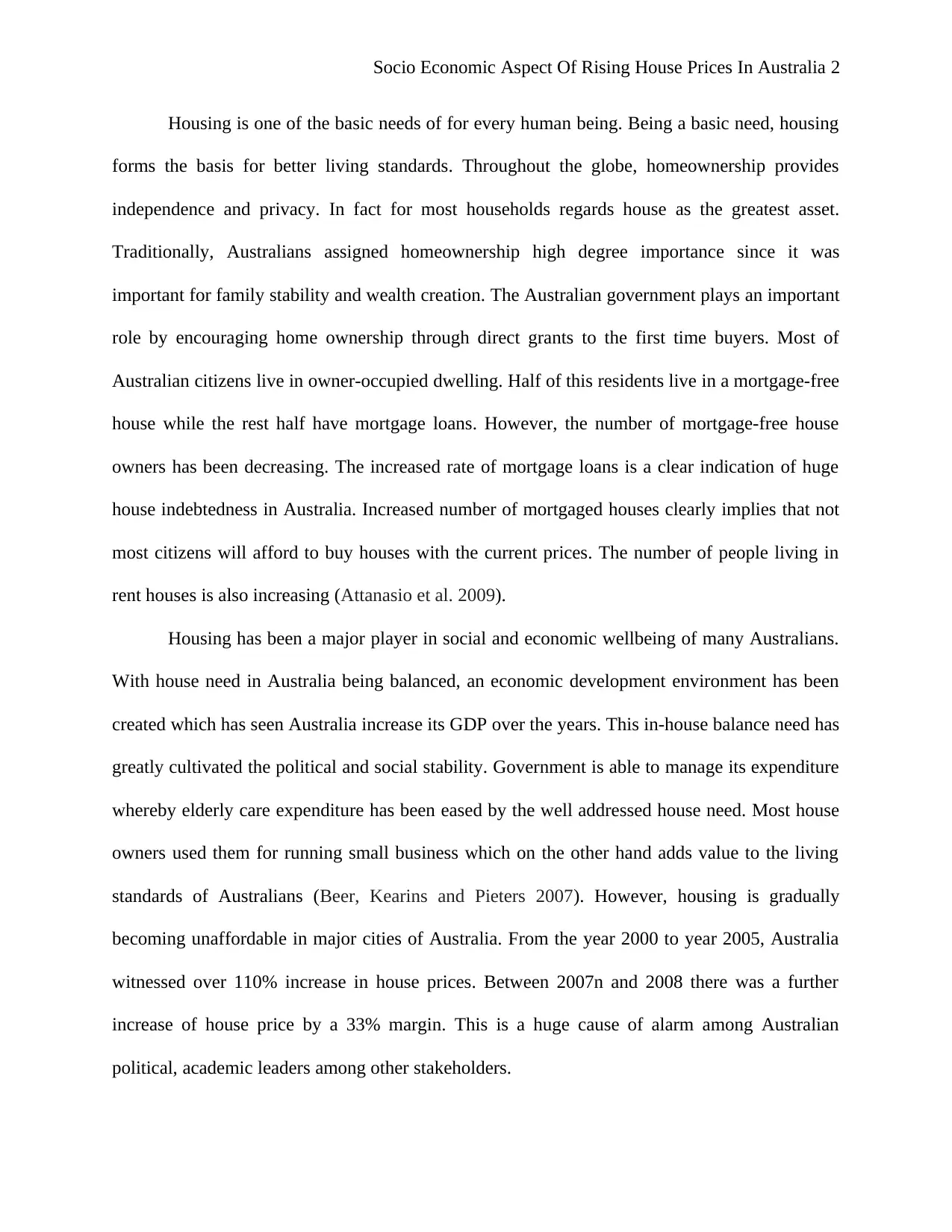
Socio Economic Aspect Of Rising House Prices In Australia 2
Housing is one of the basic needs of for every human being. Being a basic need, housing
forms the basis for better living standards. Throughout the globe, homeownership provides
independence and privacy. In fact for most households regards house as the greatest asset.
Traditionally, Australians assigned homeownership high degree importance since it was
important for family stability and wealth creation. The Australian government plays an important
role by encouraging home ownership through direct grants to the first time buyers. Most of
Australian citizens live in owner-occupied dwelling. Half of this residents live in a mortgage-free
house while the rest half have mortgage loans. However, the number of mortgage-free house
owners has been decreasing. The increased rate of mortgage loans is a clear indication of huge
house indebtedness in Australia. Increased number of mortgaged houses clearly implies that not
most citizens will afford to buy houses with the current prices. The number of people living in
rent houses is also increasing (Attanasio et al. 2009).
Housing has been a major player in social and economic wellbeing of many Australians.
With house need in Australia being balanced, an economic development environment has been
created which has seen Australia increase its GDP over the years. This in-house balance need has
greatly cultivated the political and social stability. Government is able to manage its expenditure
whereby elderly care expenditure has been eased by the well addressed house need. Most house
owners used them for running small business which on the other hand adds value to the living
standards of Australians (Beer, Kearins and Pieters 2007). However, housing is gradually
becoming unaffordable in major cities of Australia. From the year 2000 to year 2005, Australia
witnessed over 110% increase in house prices. Between 2007n and 2008 there was a further
increase of house price by a 33% margin. This is a huge cause of alarm among Australian
political, academic leaders among other stakeholders.
Housing is one of the basic needs of for every human being. Being a basic need, housing
forms the basis for better living standards. Throughout the globe, homeownership provides
independence and privacy. In fact for most households regards house as the greatest asset.
Traditionally, Australians assigned homeownership high degree importance since it was
important for family stability and wealth creation. The Australian government plays an important
role by encouraging home ownership through direct grants to the first time buyers. Most of
Australian citizens live in owner-occupied dwelling. Half of this residents live in a mortgage-free
house while the rest half have mortgage loans. However, the number of mortgage-free house
owners has been decreasing. The increased rate of mortgage loans is a clear indication of huge
house indebtedness in Australia. Increased number of mortgaged houses clearly implies that not
most citizens will afford to buy houses with the current prices. The number of people living in
rent houses is also increasing (Attanasio et al. 2009).
Housing has been a major player in social and economic wellbeing of many Australians.
With house need in Australia being balanced, an economic development environment has been
created which has seen Australia increase its GDP over the years. This in-house balance need has
greatly cultivated the political and social stability. Government is able to manage its expenditure
whereby elderly care expenditure has been eased by the well addressed house need. Most house
owners used them for running small business which on the other hand adds value to the living
standards of Australians (Beer, Kearins and Pieters 2007). However, housing is gradually
becoming unaffordable in major cities of Australia. From the year 2000 to year 2005, Australia
witnessed over 110% increase in house prices. Between 2007n and 2008 there was a further
increase of house price by a 33% margin. This is a huge cause of alarm among Australian
political, academic leaders among other stakeholders.
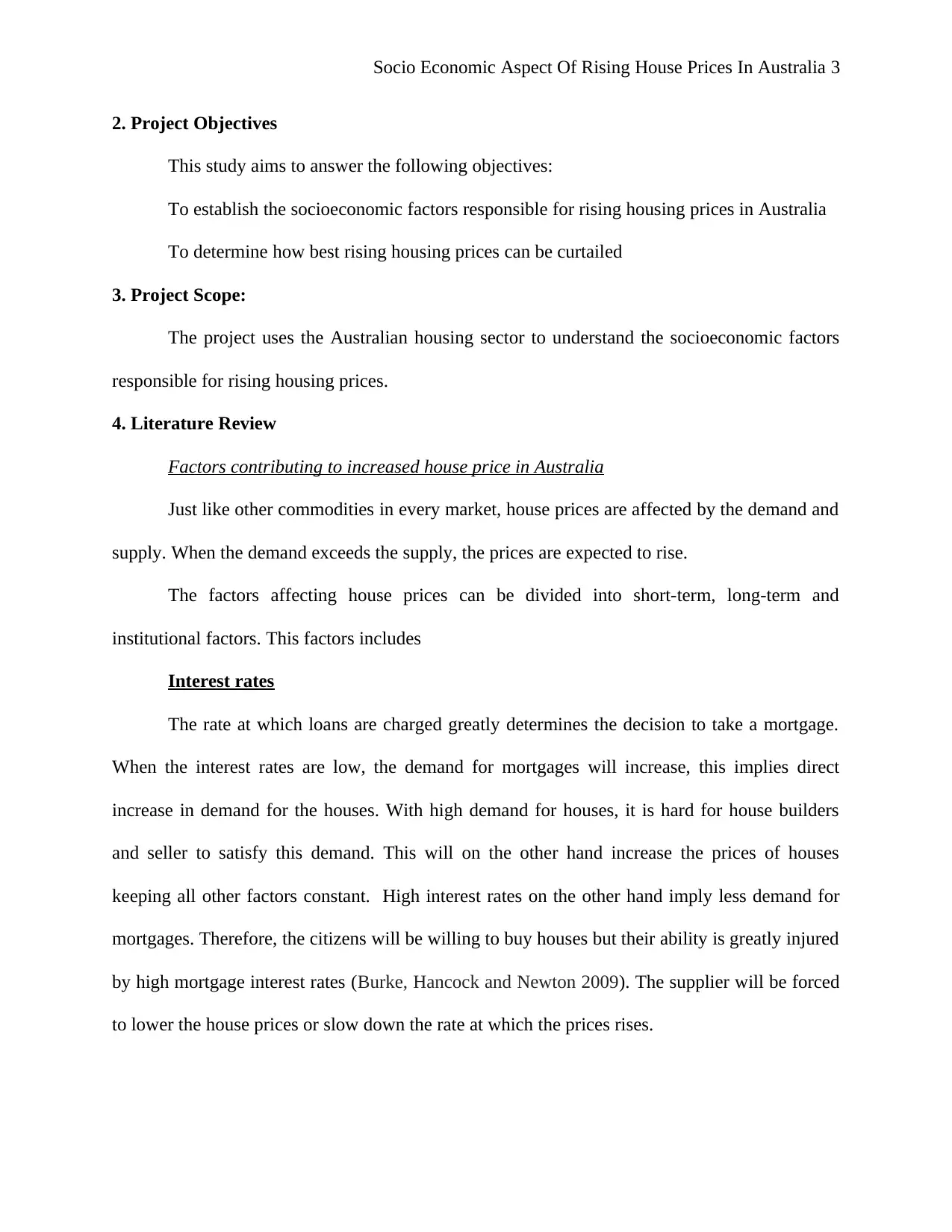
Socio Economic Aspect Of Rising House Prices In Australia 3
2. Project Objectives
This study aims to answer the following objectives:
To establish the socioeconomic factors responsible for rising housing prices in Australia
To determine how best rising housing prices can be curtailed
3. Project Scope:
The project uses the Australian housing sector to understand the socioeconomic factors
responsible for rising housing prices.
4. Literature Review
Factors contributing to increased house price in Australia
Just like other commodities in every market, house prices are affected by the demand and
supply. When the demand exceeds the supply, the prices are expected to rise.
The factors affecting house prices can be divided into short-term, long-term and
institutional factors. This factors includes
Interest rates
The rate at which loans are charged greatly determines the decision to take a mortgage.
When the interest rates are low, the demand for mortgages will increase, this implies direct
increase in demand for the houses. With high demand for houses, it is hard for house builders
and seller to satisfy this demand. This will on the other hand increase the prices of houses
keeping all other factors constant. High interest rates on the other hand imply less demand for
mortgages. Therefore, the citizens will be willing to buy houses but their ability is greatly injured
by high mortgage interest rates (Burke, Hancock and Newton 2009). The supplier will be forced
to lower the house prices or slow down the rate at which the prices rises.
2. Project Objectives
This study aims to answer the following objectives:
To establish the socioeconomic factors responsible for rising housing prices in Australia
To determine how best rising housing prices can be curtailed
3. Project Scope:
The project uses the Australian housing sector to understand the socioeconomic factors
responsible for rising housing prices.
4. Literature Review
Factors contributing to increased house price in Australia
Just like other commodities in every market, house prices are affected by the demand and
supply. When the demand exceeds the supply, the prices are expected to rise.
The factors affecting house prices can be divided into short-term, long-term and
institutional factors. This factors includes
Interest rates
The rate at which loans are charged greatly determines the decision to take a mortgage.
When the interest rates are low, the demand for mortgages will increase, this implies direct
increase in demand for the houses. With high demand for houses, it is hard for house builders
and seller to satisfy this demand. This will on the other hand increase the prices of houses
keeping all other factors constant. High interest rates on the other hand imply less demand for
mortgages. Therefore, the citizens will be willing to buy houses but their ability is greatly injured
by high mortgage interest rates (Burke, Hancock and Newton 2009). The supplier will be forced
to lower the house prices or slow down the rate at which the prices rises.
⊘ This is a preview!⊘
Do you want full access?
Subscribe today to unlock all pages.

Trusted by 1+ million students worldwide
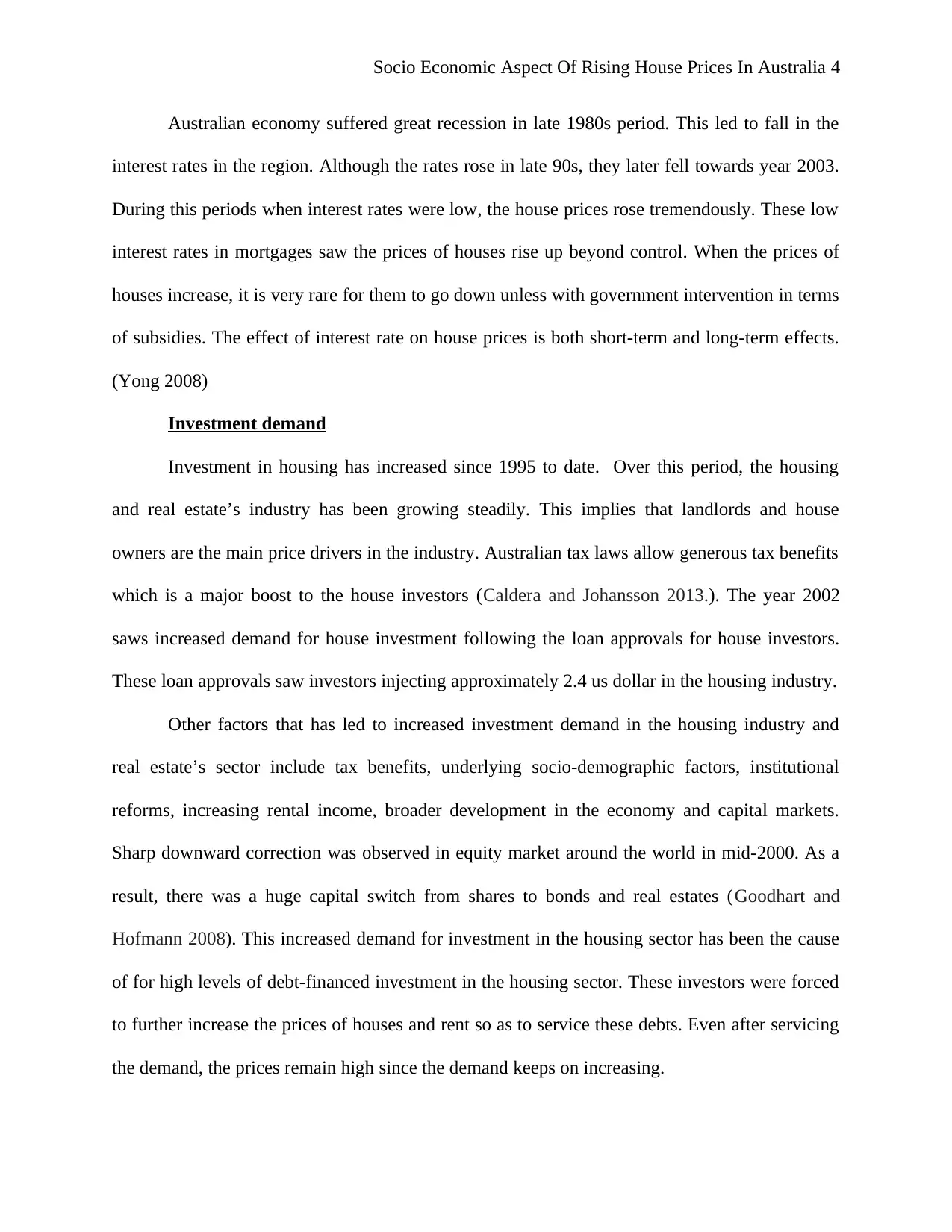
Socio Economic Aspect Of Rising House Prices In Australia 4
Australian economy suffered great recession in late 1980s period. This led to fall in the
interest rates in the region. Although the rates rose in late 90s, they later fell towards year 2003.
During this periods when interest rates were low, the house prices rose tremendously. These low
interest rates in mortgages saw the prices of houses rise up beyond control. When the prices of
houses increase, it is very rare for them to go down unless with government intervention in terms
of subsidies. The effect of interest rate on house prices is both short-term and long-term effects.
(Yong 2008)
Investment demand
Investment in housing has increased since 1995 to date. Over this period, the housing
and real estate’s industry has been growing steadily. This implies that landlords and house
owners are the main price drivers in the industry. Australian tax laws allow generous tax benefits
which is a major boost to the house investors (Caldera and Johansson 2013.). The year 2002
saws increased demand for house investment following the loan approvals for house investors.
These loan approvals saw investors injecting approximately 2.4 us dollar in the housing industry.
Other factors that has led to increased investment demand in the housing industry and
real estate’s sector include tax benefits, underlying socio-demographic factors, institutional
reforms, increasing rental income, broader development in the economy and capital markets.
Sharp downward correction was observed in equity market around the world in mid-2000. As a
result, there was a huge capital switch from shares to bonds and real estates (Goodhart and
Hofmann 2008). This increased demand for investment in the housing sector has been the cause
of for high levels of debt-financed investment in the housing sector. These investors were forced
to further increase the prices of houses and rent so as to service these debts. Even after servicing
the demand, the prices remain high since the demand keeps on increasing.
Australian economy suffered great recession in late 1980s period. This led to fall in the
interest rates in the region. Although the rates rose in late 90s, they later fell towards year 2003.
During this periods when interest rates were low, the house prices rose tremendously. These low
interest rates in mortgages saw the prices of houses rise up beyond control. When the prices of
houses increase, it is very rare for them to go down unless with government intervention in terms
of subsidies. The effect of interest rate on house prices is both short-term and long-term effects.
(Yong 2008)
Investment demand
Investment in housing has increased since 1995 to date. Over this period, the housing
and real estate’s industry has been growing steadily. This implies that landlords and house
owners are the main price drivers in the industry. Australian tax laws allow generous tax benefits
which is a major boost to the house investors (Caldera and Johansson 2013.). The year 2002
saws increased demand for house investment following the loan approvals for house investors.
These loan approvals saw investors injecting approximately 2.4 us dollar in the housing industry.
Other factors that has led to increased investment demand in the housing industry and
real estate’s sector include tax benefits, underlying socio-demographic factors, institutional
reforms, increasing rental income, broader development in the economy and capital markets.
Sharp downward correction was observed in equity market around the world in mid-2000. As a
result, there was a huge capital switch from shares to bonds and real estates (Goodhart and
Hofmann 2008). This increased demand for investment in the housing sector has been the cause
of for high levels of debt-financed investment in the housing sector. These investors were forced
to further increase the prices of houses and rent so as to service these debts. Even after servicing
the demand, the prices remain high since the demand keeps on increasing.
Paraphrase This Document
Need a fresh take? Get an instant paraphrase of this document with our AI Paraphraser
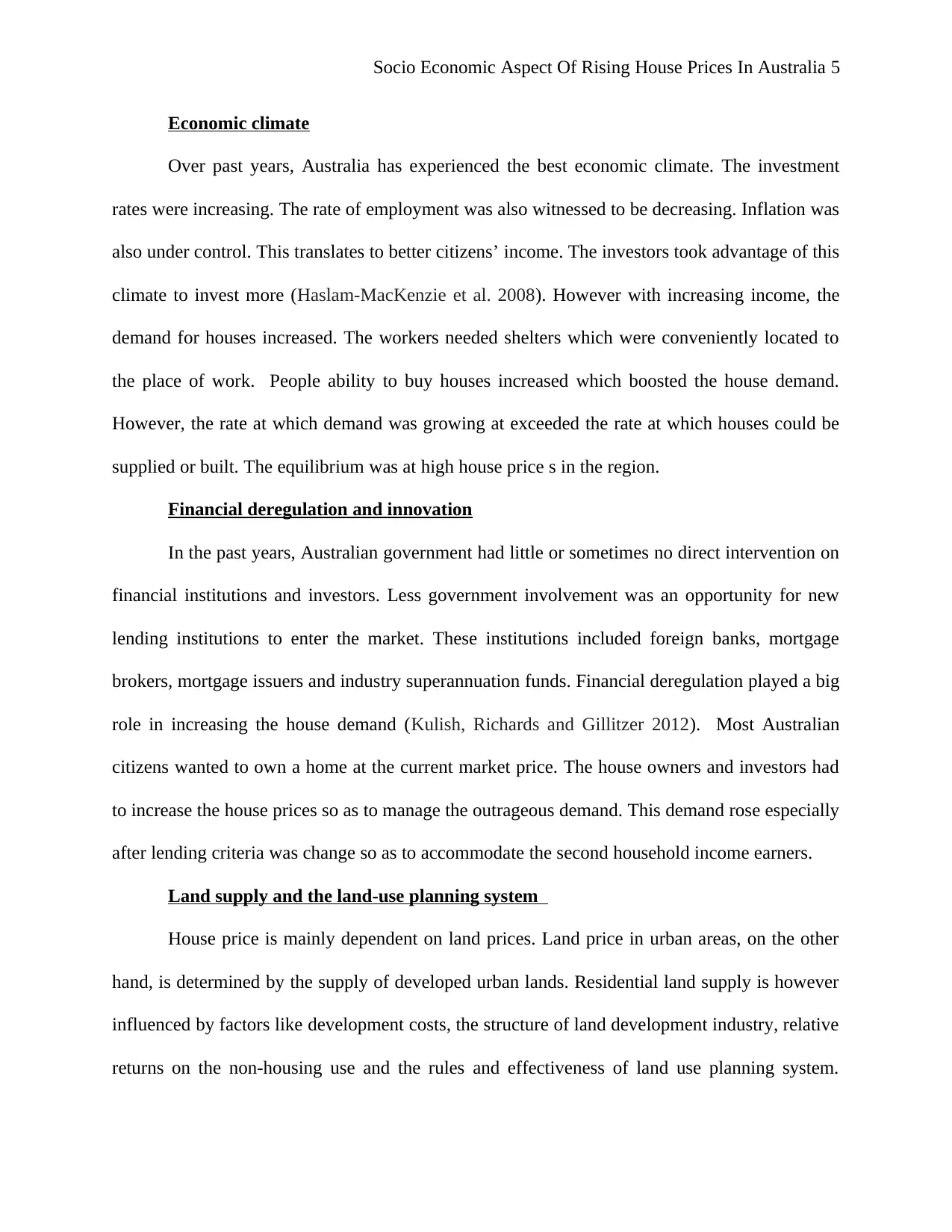
Socio Economic Aspect Of Rising House Prices In Australia 5
Economic climate
Over past years, Australia has experienced the best economic climate. The investment
rates were increasing. The rate of employment was also witnessed to be decreasing. Inflation was
also under control. This translates to better citizens’ income. The investors took advantage of this
climate to invest more (Haslam-MacKenzie et al. 2008). However with increasing income, the
demand for houses increased. The workers needed shelters which were conveniently located to
the place of work. People ability to buy houses increased which boosted the house demand.
However, the rate at which demand was growing at exceeded the rate at which houses could be
supplied or built. The equilibrium was at high house price s in the region.
Financial deregulation and innovation
In the past years, Australian government had little or sometimes no direct intervention on
financial institutions and investors. Less government involvement was an opportunity for new
lending institutions to enter the market. These institutions included foreign banks, mortgage
brokers, mortgage issuers and industry superannuation funds. Financial deregulation played a big
role in increasing the house demand (Kulish, Richards and Gillitzer 2012). Most Australian
citizens wanted to own a home at the current market price. The house owners and investors had
to increase the house prices so as to manage the outrageous demand. This demand rose especially
after lending criteria was change so as to accommodate the second household income earners.
Land supply and the land-use planning system
House price is mainly dependent on land prices. Land price in urban areas, on the other
hand, is determined by the supply of developed urban lands. Residential land supply is however
influenced by factors like development costs, the structure of land development industry, relative
returns on the non-housing use and the rules and effectiveness of land use planning system.
Economic climate
Over past years, Australia has experienced the best economic climate. The investment
rates were increasing. The rate of employment was also witnessed to be decreasing. Inflation was
also under control. This translates to better citizens’ income. The investors took advantage of this
climate to invest more (Haslam-MacKenzie et al. 2008). However with increasing income, the
demand for houses increased. The workers needed shelters which were conveniently located to
the place of work. People ability to buy houses increased which boosted the house demand.
However, the rate at which demand was growing at exceeded the rate at which houses could be
supplied or built. The equilibrium was at high house price s in the region.
Financial deregulation and innovation
In the past years, Australian government had little or sometimes no direct intervention on
financial institutions and investors. Less government involvement was an opportunity for new
lending institutions to enter the market. These institutions included foreign banks, mortgage
brokers, mortgage issuers and industry superannuation funds. Financial deregulation played a big
role in increasing the house demand (Kulish, Richards and Gillitzer 2012). Most Australian
citizens wanted to own a home at the current market price. The house owners and investors had
to increase the house prices so as to manage the outrageous demand. This demand rose especially
after lending criteria was change so as to accommodate the second household income earners.
Land supply and the land-use planning system
House price is mainly dependent on land prices. Land price in urban areas, on the other
hand, is determined by the supply of developed urban lands. Residential land supply is however
influenced by factors like development costs, the structure of land development industry, relative
returns on the non-housing use and the rules and effectiveness of land use planning system.
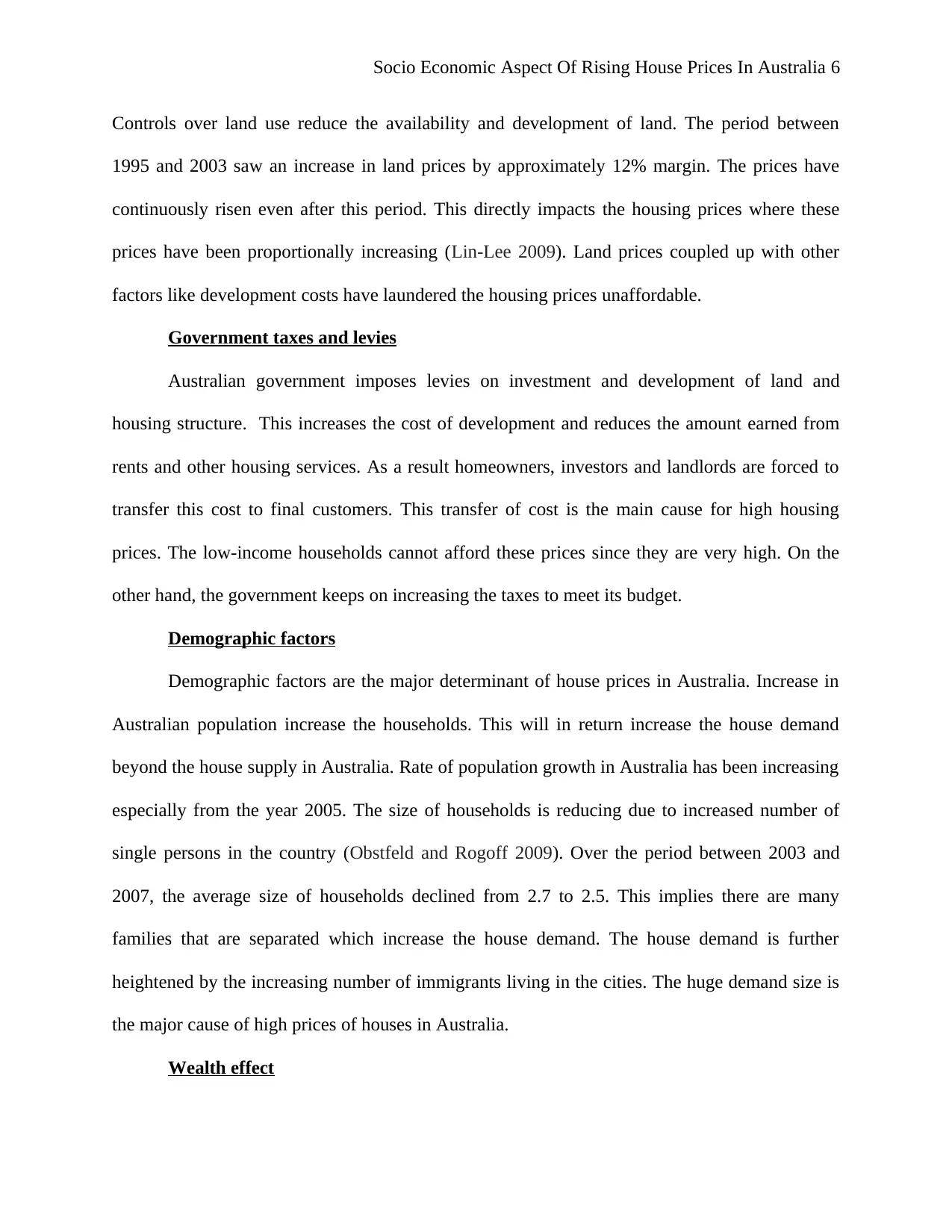
Socio Economic Aspect Of Rising House Prices In Australia 6
Controls over land use reduce the availability and development of land. The period between
1995 and 2003 saw an increase in land prices by approximately 12% margin. The prices have
continuously risen even after this period. This directly impacts the housing prices where these
prices have been proportionally increasing (Lin-Lee 2009). Land prices coupled up with other
factors like development costs have laundered the housing prices unaffordable.
Government taxes and levies
Australian government imposes levies on investment and development of land and
housing structure. This increases the cost of development and reduces the amount earned from
rents and other housing services. As a result homeowners, investors and landlords are forced to
transfer this cost to final customers. This transfer of cost is the main cause for high housing
prices. The low-income households cannot afford these prices since they are very high. On the
other hand, the government keeps on increasing the taxes to meet its budget.
Demographic factors
Demographic factors are the major determinant of house prices in Australia. Increase in
Australian population increase the households. This will in return increase the house demand
beyond the house supply in Australia. Rate of population growth in Australia has been increasing
especially from the year 2005. The size of households is reducing due to increased number of
single persons in the country (Obstfeld and Rogoff 2009). Over the period between 2003 and
2007, the average size of households declined from 2.7 to 2.5. This implies there are many
families that are separated which increase the house demand. The house demand is further
heightened by the increasing number of immigrants living in the cities. The huge demand size is
the major cause of high prices of houses in Australia.
Wealth effect
Controls over land use reduce the availability and development of land. The period between
1995 and 2003 saw an increase in land prices by approximately 12% margin. The prices have
continuously risen even after this period. This directly impacts the housing prices where these
prices have been proportionally increasing (Lin-Lee 2009). Land prices coupled up with other
factors like development costs have laundered the housing prices unaffordable.
Government taxes and levies
Australian government imposes levies on investment and development of land and
housing structure. This increases the cost of development and reduces the amount earned from
rents and other housing services. As a result homeowners, investors and landlords are forced to
transfer this cost to final customers. This transfer of cost is the main cause for high housing
prices. The low-income households cannot afford these prices since they are very high. On the
other hand, the government keeps on increasing the taxes to meet its budget.
Demographic factors
Demographic factors are the major determinant of house prices in Australia. Increase in
Australian population increase the households. This will in return increase the house demand
beyond the house supply in Australia. Rate of population growth in Australia has been increasing
especially from the year 2005. The size of households is reducing due to increased number of
single persons in the country (Obstfeld and Rogoff 2009). Over the period between 2003 and
2007, the average size of households declined from 2.7 to 2.5. This implies there are many
families that are separated which increase the house demand. The house demand is further
heightened by the increasing number of immigrants living in the cities. The huge demand size is
the major cause of high prices of houses in Australia.
Wealth effect
⊘ This is a preview!⊘
Do you want full access?
Subscribe today to unlock all pages.

Trusted by 1+ million students worldwide
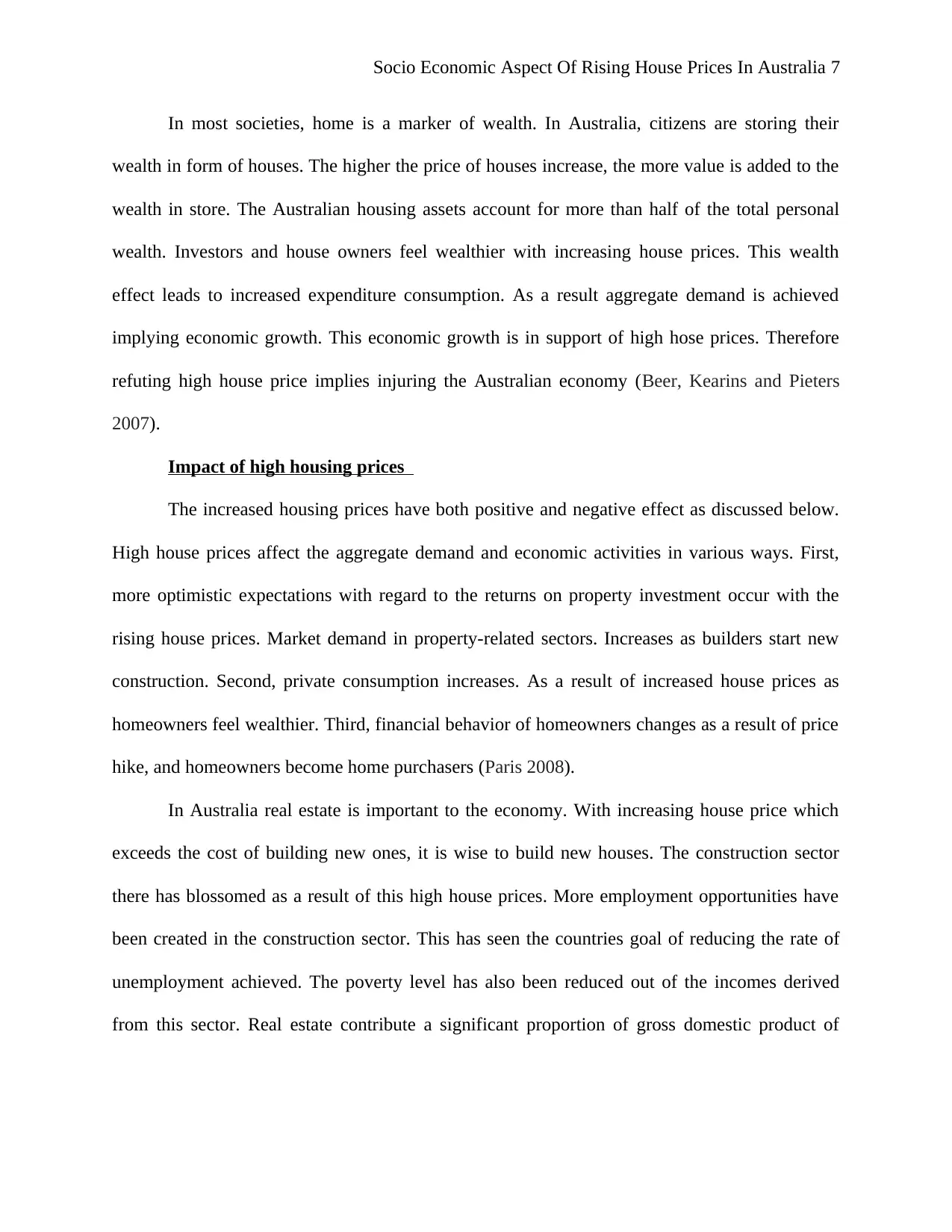
Socio Economic Aspect Of Rising House Prices In Australia 7
In most societies, home is a marker of wealth. In Australia, citizens are storing their
wealth in form of houses. The higher the price of houses increase, the more value is added to the
wealth in store. The Australian housing assets account for more than half of the total personal
wealth. Investors and house owners feel wealthier with increasing house prices. This wealth
effect leads to increased expenditure consumption. As a result aggregate demand is achieved
implying economic growth. This economic growth is in support of high hose prices. Therefore
refuting high house price implies injuring the Australian economy (Beer, Kearins and Pieters
2007).
Impact of high housing prices
The increased housing prices have both positive and negative effect as discussed below.
High house prices affect the aggregate demand and economic activities in various ways. First,
more optimistic expectations with regard to the returns on property investment occur with the
rising house prices. Market demand in property-related sectors. Increases as builders start new
construction. Second, private consumption increases. As a result of increased house prices as
homeowners feel wealthier. Third, financial behavior of homeowners changes as a result of price
hike, and homeowners become home purchasers (Paris 2008).
In Australia real estate is important to the economy. With increasing house price which
exceeds the cost of building new ones, it is wise to build new houses. The construction sector
there has blossomed as a result of this high house prices. More employment opportunities have
been created in the construction sector. This has seen the countries goal of reducing the rate of
unemployment achieved. The poverty level has also been reduced out of the incomes derived
from this sector. Real estate contribute a significant proportion of gross domestic product of
In most societies, home is a marker of wealth. In Australia, citizens are storing their
wealth in form of houses. The higher the price of houses increase, the more value is added to the
wealth in store. The Australian housing assets account for more than half of the total personal
wealth. Investors and house owners feel wealthier with increasing house prices. This wealth
effect leads to increased expenditure consumption. As a result aggregate demand is achieved
implying economic growth. This economic growth is in support of high hose prices. Therefore
refuting high house price implies injuring the Australian economy (Beer, Kearins and Pieters
2007).
Impact of high housing prices
The increased housing prices have both positive and negative effect as discussed below.
High house prices affect the aggregate demand and economic activities in various ways. First,
more optimistic expectations with regard to the returns on property investment occur with the
rising house prices. Market demand in property-related sectors. Increases as builders start new
construction. Second, private consumption increases. As a result of increased house prices as
homeowners feel wealthier. Third, financial behavior of homeowners changes as a result of price
hike, and homeowners become home purchasers (Paris 2008).
In Australia real estate is important to the economy. With increasing house price which
exceeds the cost of building new ones, it is wise to build new houses. The construction sector
there has blossomed as a result of this high house prices. More employment opportunities have
been created in the construction sector. This has seen the countries goal of reducing the rate of
unemployment achieved. The poverty level has also been reduced out of the incomes derived
from this sector. Real estate contribute a significant proportion of gross domestic product of
Paraphrase This Document
Need a fresh take? Get an instant paraphrase of this document with our AI Paraphraser
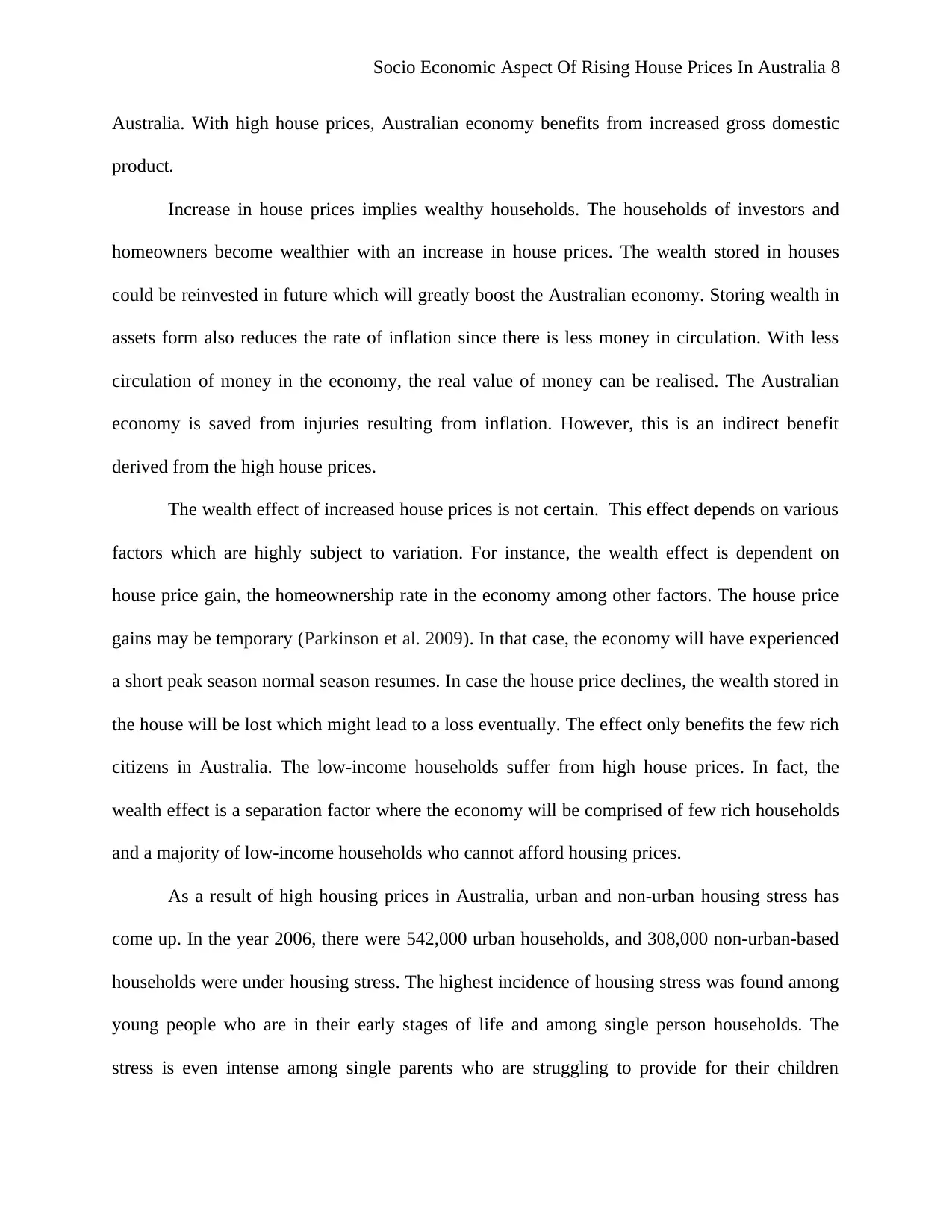
Socio Economic Aspect Of Rising House Prices In Australia 8
Australia. With high house prices, Australian economy benefits from increased gross domestic
product.
Increase in house prices implies wealthy households. The households of investors and
homeowners become wealthier with an increase in house prices. The wealth stored in houses
could be reinvested in future which will greatly boost the Australian economy. Storing wealth in
assets form also reduces the rate of inflation since there is less money in circulation. With less
circulation of money in the economy, the real value of money can be realised. The Australian
economy is saved from injuries resulting from inflation. However, this is an indirect benefit
derived from the high house prices.
The wealth effect of increased house prices is not certain. This effect depends on various
factors which are highly subject to variation. For instance, the wealth effect is dependent on
house price gain, the homeownership rate in the economy among other factors. The house price
gains may be temporary (Parkinson et al. 2009). In that case, the economy will have experienced
a short peak season normal season resumes. In case the house price declines, the wealth stored in
the house will be lost which might lead to a loss eventually. The effect only benefits the few rich
citizens in Australia. The low-income households suffer from high house prices. In fact, the
wealth effect is a separation factor where the economy will be comprised of few rich households
and a majority of low-income households who cannot afford housing prices.
As a result of high housing prices in Australia, urban and non-urban housing stress has
come up. In the year 2006, there were 542,000 urban households, and 308,000 non-urban-based
households were under housing stress. The highest incidence of housing stress was found among
young people who are in their early stages of life and among single person households. The
stress is even intense among single parents who are struggling to provide for their children
Australia. With high house prices, Australian economy benefits from increased gross domestic
product.
Increase in house prices implies wealthy households. The households of investors and
homeowners become wealthier with an increase in house prices. The wealth stored in houses
could be reinvested in future which will greatly boost the Australian economy. Storing wealth in
assets form also reduces the rate of inflation since there is less money in circulation. With less
circulation of money in the economy, the real value of money can be realised. The Australian
economy is saved from injuries resulting from inflation. However, this is an indirect benefit
derived from the high house prices.
The wealth effect of increased house prices is not certain. This effect depends on various
factors which are highly subject to variation. For instance, the wealth effect is dependent on
house price gain, the homeownership rate in the economy among other factors. The house price
gains may be temporary (Parkinson et al. 2009). In that case, the economy will have experienced
a short peak season normal season resumes. In case the house price declines, the wealth stored in
the house will be lost which might lead to a loss eventually. The effect only benefits the few rich
citizens in Australia. The low-income households suffer from high house prices. In fact, the
wealth effect is a separation factor where the economy will be comprised of few rich households
and a majority of low-income households who cannot afford housing prices.
As a result of high housing prices in Australia, urban and non-urban housing stress has
come up. In the year 2006, there were 542,000 urban households, and 308,000 non-urban-based
households were under housing stress. The highest incidence of housing stress was found among
young people who are in their early stages of life and among single person households. The
stress is even intense among single parents who are struggling to provide for their children
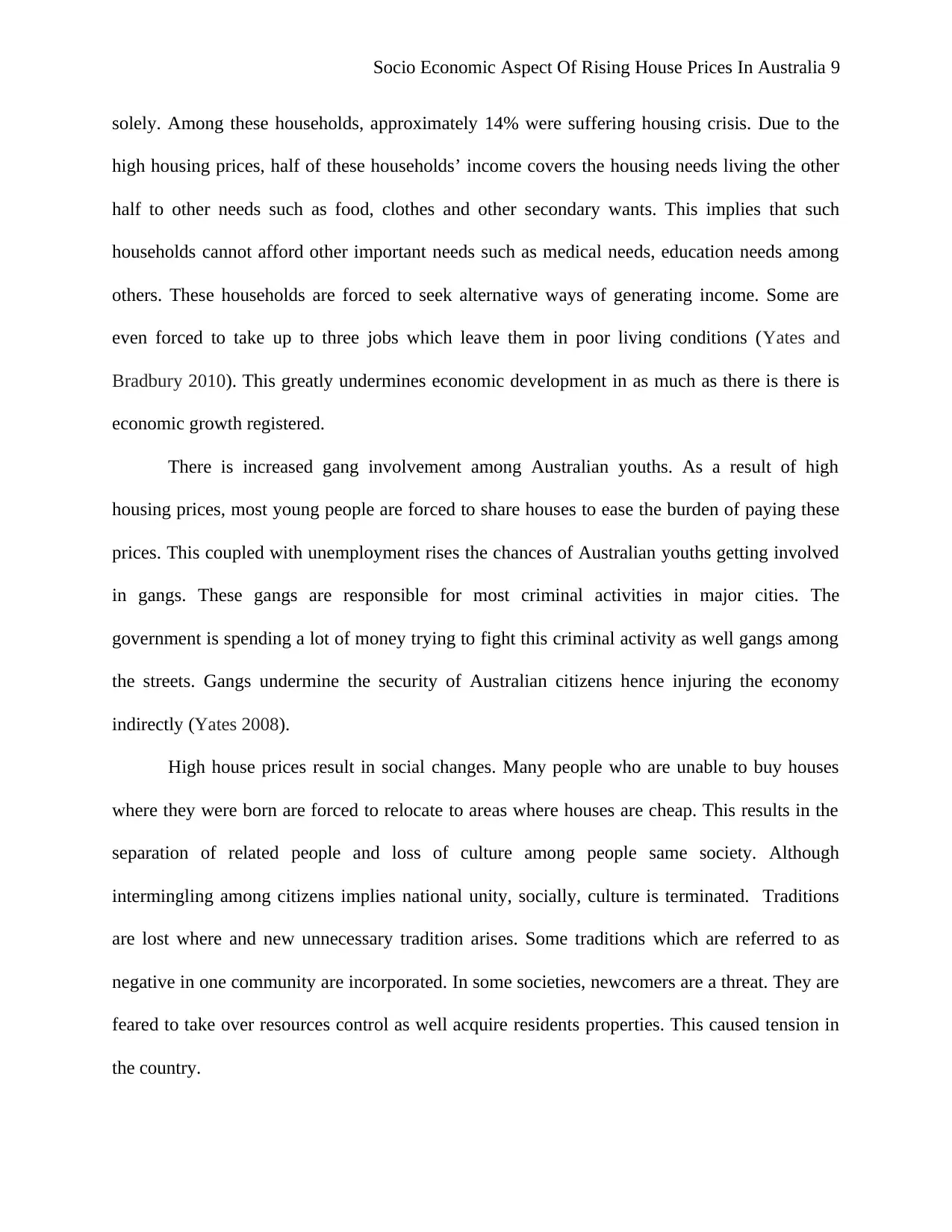
Socio Economic Aspect Of Rising House Prices In Australia 9
solely. Among these households, approximately 14% were suffering housing crisis. Due to the
high housing prices, half of these households’ income covers the housing needs living the other
half to other needs such as food, clothes and other secondary wants. This implies that such
households cannot afford other important needs such as medical needs, education needs among
others. These households are forced to seek alternative ways of generating income. Some are
even forced to take up to three jobs which leave them in poor living conditions (Yates and
Bradbury 2010). This greatly undermines economic development in as much as there is there is
economic growth registered.
There is increased gang involvement among Australian youths. As a result of high
housing prices, most young people are forced to share houses to ease the burden of paying these
prices. This coupled with unemployment rises the chances of Australian youths getting involved
in gangs. These gangs are responsible for most criminal activities in major cities. The
government is spending a lot of money trying to fight this criminal activity as well gangs among
the streets. Gangs undermine the security of Australian citizens hence injuring the economy
indirectly (Yates 2008).
High house prices result in social changes. Many people who are unable to buy houses
where they were born are forced to relocate to areas where houses are cheap. This results in the
separation of related people and loss of culture among people same society. Although
intermingling among citizens implies national unity, socially, culture is terminated. Traditions
are lost where and new unnecessary tradition arises. Some traditions which are referred to as
negative in one community are incorporated. In some societies, newcomers are a threat. They are
feared to take over resources control as well acquire residents properties. This caused tension in
the country.
solely. Among these households, approximately 14% were suffering housing crisis. Due to the
high housing prices, half of these households’ income covers the housing needs living the other
half to other needs such as food, clothes and other secondary wants. This implies that such
households cannot afford other important needs such as medical needs, education needs among
others. These households are forced to seek alternative ways of generating income. Some are
even forced to take up to three jobs which leave them in poor living conditions (Yates and
Bradbury 2010). This greatly undermines economic development in as much as there is there is
economic growth registered.
There is increased gang involvement among Australian youths. As a result of high
housing prices, most young people are forced to share houses to ease the burden of paying these
prices. This coupled with unemployment rises the chances of Australian youths getting involved
in gangs. These gangs are responsible for most criminal activities in major cities. The
government is spending a lot of money trying to fight this criminal activity as well gangs among
the streets. Gangs undermine the security of Australian citizens hence injuring the economy
indirectly (Yates 2008).
High house prices result in social changes. Many people who are unable to buy houses
where they were born are forced to relocate to areas where houses are cheap. This results in the
separation of related people and loss of culture among people same society. Although
intermingling among citizens implies national unity, socially, culture is terminated. Traditions
are lost where and new unnecessary tradition arises. Some traditions which are referred to as
negative in one community are incorporated. In some societies, newcomers are a threat. They are
feared to take over resources control as well acquire residents properties. This caused tension in
the country.
⊘ This is a preview!⊘
Do you want full access?
Subscribe today to unlock all pages.

Trusted by 1+ million students worldwide
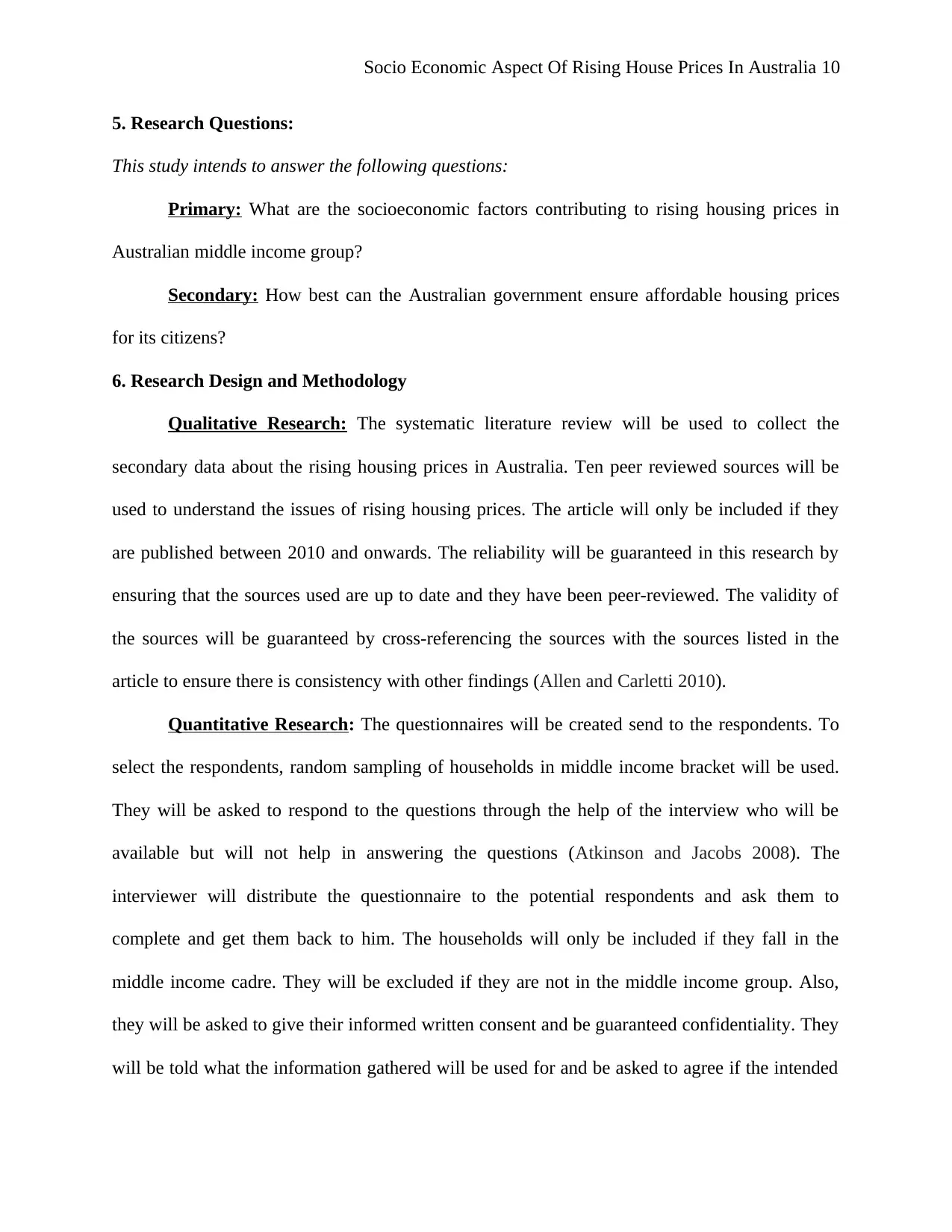
Socio Economic Aspect Of Rising House Prices In Australia 10
5. Research Questions:
This study intends to answer the following questions:
Primary: What are the socioeconomic factors contributing to rising housing prices in
Australian middle income group?
Secondary: How best can the Australian government ensure affordable housing prices
for its citizens?
6. Research Design and Methodology
Qualitative Research: The systematic literature review will be used to collect the
secondary data about the rising housing prices in Australia. Ten peer reviewed sources will be
used to understand the issues of rising housing prices. The article will only be included if they
are published between 2010 and onwards. The reliability will be guaranteed in this research by
ensuring that the sources used are up to date and they have been peer-reviewed. The validity of
the sources will be guaranteed by cross-referencing the sources with the sources listed in the
article to ensure there is consistency with other findings (Allen and Carletti 2010).
Quantitative Research: The questionnaires will be created send to the respondents. To
select the respondents, random sampling of households in middle income bracket will be used.
They will be asked to respond to the questions through the help of the interview who will be
available but will not help in answering the questions (Atkinson and Jacobs 2008). The
interviewer will distribute the questionnaire to the potential respondents and ask them to
complete and get them back to him. The households will only be included if they fall in the
middle income cadre. They will be excluded if they are not in the middle income group. Also,
they will be asked to give their informed written consent and be guaranteed confidentiality. They
will be told what the information gathered will be used for and be asked to agree if the intended
5. Research Questions:
This study intends to answer the following questions:
Primary: What are the socioeconomic factors contributing to rising housing prices in
Australian middle income group?
Secondary: How best can the Australian government ensure affordable housing prices
for its citizens?
6. Research Design and Methodology
Qualitative Research: The systematic literature review will be used to collect the
secondary data about the rising housing prices in Australia. Ten peer reviewed sources will be
used to understand the issues of rising housing prices. The article will only be included if they
are published between 2010 and onwards. The reliability will be guaranteed in this research by
ensuring that the sources used are up to date and they have been peer-reviewed. The validity of
the sources will be guaranteed by cross-referencing the sources with the sources listed in the
article to ensure there is consistency with other findings (Allen and Carletti 2010).
Quantitative Research: The questionnaires will be created send to the respondents. To
select the respondents, random sampling of households in middle income bracket will be used.
They will be asked to respond to the questions through the help of the interview who will be
available but will not help in answering the questions (Atkinson and Jacobs 2008). The
interviewer will distribute the questionnaire to the potential respondents and ask them to
complete and get them back to him. The households will only be included if they fall in the
middle income cadre. They will be excluded if they are not in the middle income group. Also,
they will be asked to give their informed written consent and be guaranteed confidentiality. They
will be told what the information gathered will be used for and be asked to agree if the intended
Paraphrase This Document
Need a fresh take? Get an instant paraphrase of this document with our AI Paraphraser
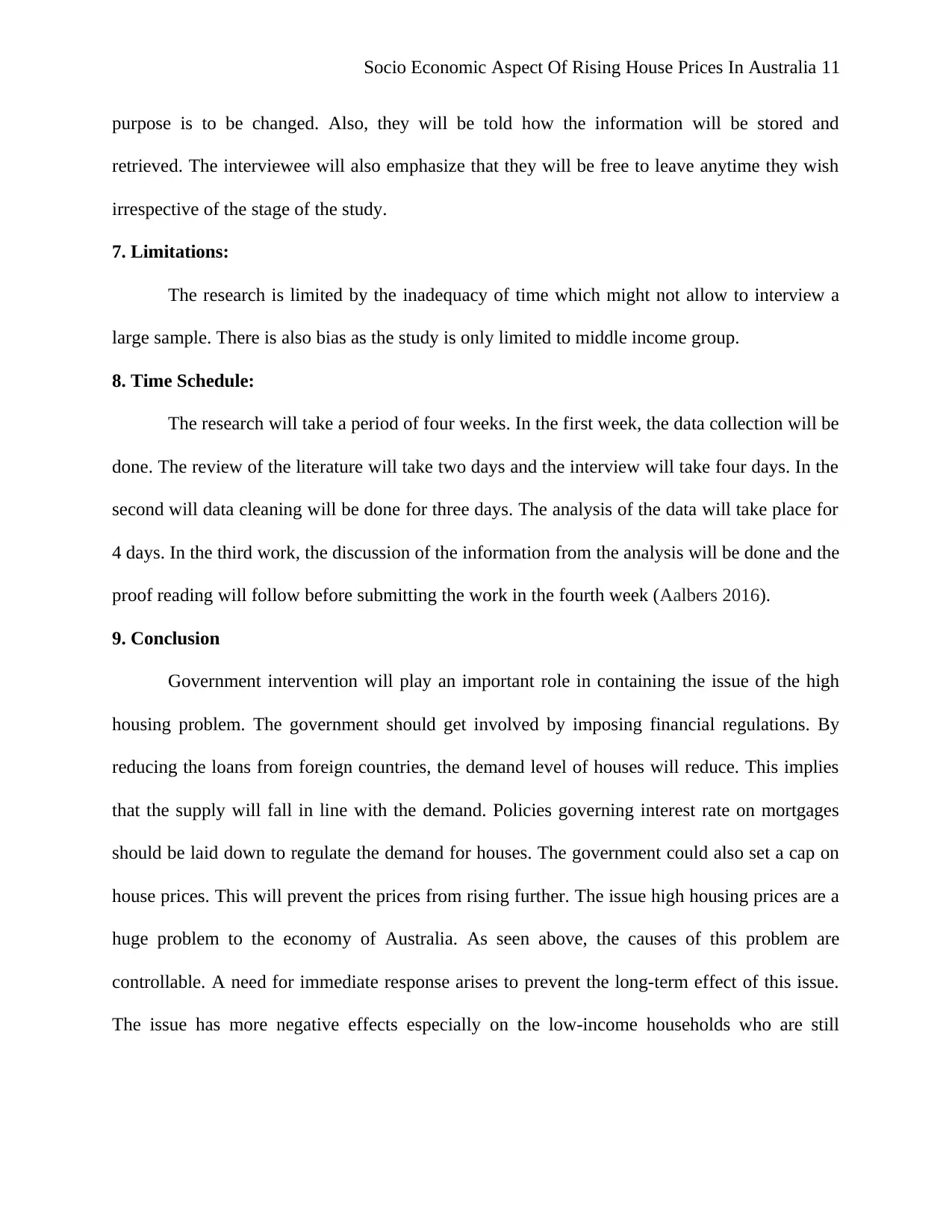
Socio Economic Aspect Of Rising House Prices In Australia 11
purpose is to be changed. Also, they will be told how the information will be stored and
retrieved. The interviewee will also emphasize that they will be free to leave anytime they wish
irrespective of the stage of the study.
7. Limitations:
The research is limited by the inadequacy of time which might not allow to interview a
large sample. There is also bias as the study is only limited to middle income group.
8. Time Schedule:
The research will take a period of four weeks. In the first week, the data collection will be
done. The review of the literature will take two days and the interview will take four days. In the
second will data cleaning will be done for three days. The analysis of the data will take place for
4 days. In the third work, the discussion of the information from the analysis will be done and the
proof reading will follow before submitting the work in the fourth week (Aalbers 2016).
9. Conclusion
Government intervention will play an important role in containing the issue of the high
housing problem. The government should get involved by imposing financial regulations. By
reducing the loans from foreign countries, the demand level of houses will reduce. This implies
that the supply will fall in line with the demand. Policies governing interest rate on mortgages
should be laid down to regulate the demand for houses. The government could also set a cap on
house prices. This will prevent the prices from rising further. The issue high housing prices are a
huge problem to the economy of Australia. As seen above, the causes of this problem are
controllable. A need for immediate response arises to prevent the long-term effect of this issue.
The issue has more negative effects especially on the low-income households who are still
purpose is to be changed. Also, they will be told how the information will be stored and
retrieved. The interviewee will also emphasize that they will be free to leave anytime they wish
irrespective of the stage of the study.
7. Limitations:
The research is limited by the inadequacy of time which might not allow to interview a
large sample. There is also bias as the study is only limited to middle income group.
8. Time Schedule:
The research will take a period of four weeks. In the first week, the data collection will be
done. The review of the literature will take two days and the interview will take four days. In the
second will data cleaning will be done for three days. The analysis of the data will take place for
4 days. In the third work, the discussion of the information from the analysis will be done and the
proof reading will follow before submitting the work in the fourth week (Aalbers 2016).
9. Conclusion
Government intervention will play an important role in containing the issue of the high
housing problem. The government should get involved by imposing financial regulations. By
reducing the loans from foreign countries, the demand level of houses will reduce. This implies
that the supply will fall in line with the demand. Policies governing interest rate on mortgages
should be laid down to regulate the demand for houses. The government could also set a cap on
house prices. This will prevent the prices from rising further. The issue high housing prices are a
huge problem to the economy of Australia. As seen above, the causes of this problem are
controllable. A need for immediate response arises to prevent the long-term effect of this issue.
The issue has more negative effects especially on the low-income households who are still
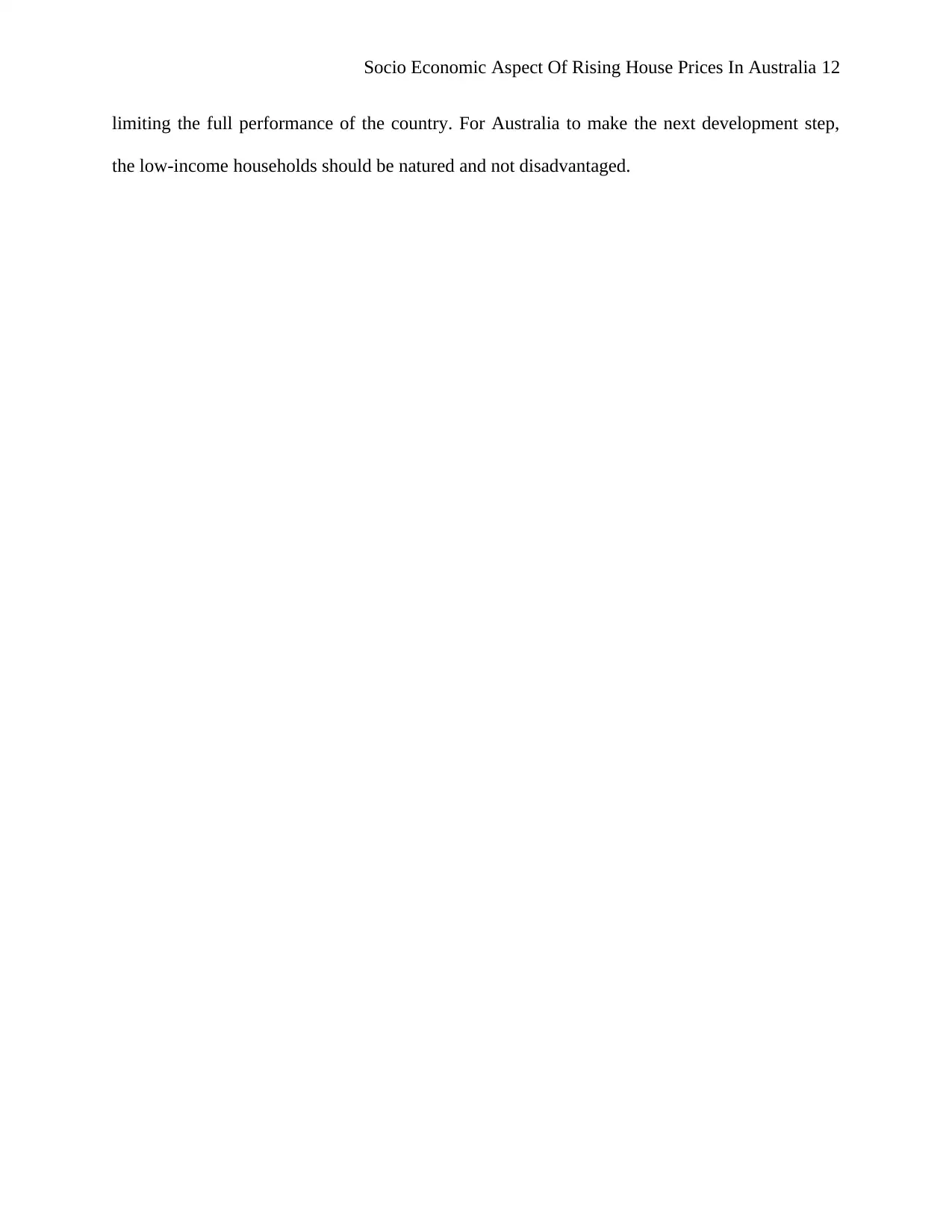
Socio Economic Aspect Of Rising House Prices In Australia 12
limiting the full performance of the country. For Australia to make the next development step,
the low-income households should be natured and not disadvantaged.
limiting the full performance of the country. For Australia to make the next development step,
the low-income households should be natured and not disadvantaged.
⊘ This is a preview!⊘
Do you want full access?
Subscribe today to unlock all pages.

Trusted by 1+ million students worldwide
1 out of 14
Related Documents
Your All-in-One AI-Powered Toolkit for Academic Success.
+13062052269
info@desklib.com
Available 24*7 on WhatsApp / Email
![[object Object]](/_next/static/media/star-bottom.7253800d.svg)
Unlock your academic potential
Copyright © 2020–2025 A2Z Services. All Rights Reserved. Developed and managed by ZUCOL.





